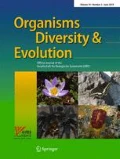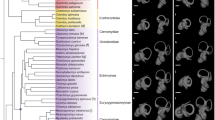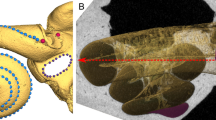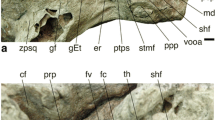Abstract
Here, we introduce the “septal compass” and the “septal formula” as a new method for phylogenetic investigations of the middle ear region in squirrel-related clade. The middle ear cavity is characterized by bony septa that divide the dorsally lying epitympanic recess and the ventrally lying tympanic cavity into several segments or diverticula. The distribution patterns of these septa are conservative among the squirrel-related clade and are restricted to the species, genus, and family level. In the studied outgroups represented by †Ischyromys typus and lagomorphs, no septa are found in the epitympanic recess and tympanic cavity. Therefore, the “septal compass” and the “septal formula” provide a new approach for phylogenetic interpretations of the middle ear region. It is user-optimized and can be modified for other rodent families and mammalian taxa and will facilitate phylogenetic assumptions in future investigations. Additionally, this method will enable the allocation of isolated tympanic bullae to the respective genus level.



Similar content being viewed by others
References
Ade, M. (1999). External morphology and evolution of the rhinarium of Lagomorpha. Mitteilungen des Museums für Naturkunde Berlin Zoologische Reihe, 75, 191–216.
Adkins, R. M., Walton, A. H., & Honeycutt, R. L. (2003). Higher-level systematics of rodents and divergence time estimates based on two congruent nuclear genes. Molecular Phylogenetics and Evolution, 26, 409–420.
Begall, S., & Burda, H. (2006). Acoustic communication and burrow acoustics are reflected in the ear morphology of the coruro (Spalacopus cyanus, Octodontidae), a social fossorial rodent. Journal of Morphology, 267, 382–390.
Blanga-Kanfi, S., Miranda, H., Penn, O., Pupko, T., DeBry, R. W., & Huchon, D. (2009). Rodent phylogeny revised: analysis of six nuclear genes from all major rodent clades. BMC Evolutionary Biology, 9, 1–12.
Bondy, G. (1908). Beiträge zur vergleichenden Anatomie des Gehörorgans bei Säugern (Tympanicum, Membrana shrapnelli und Chordaverlauf). Anatomische Hefte, 35, 293–408.
Bugge, J. (1974). The cephalic arterial system in insectivores, primates, rodents and lagomorphs, with special reference to the systematic classification. Basel: S. Karger.
DeBry, R. W., & Sagel, R. M. (2001). Phylogeny of Rodentia (Mammalia) inferred from the nuclear-encoded gene IRBP. Molecular Phylogenetics and Evolution, 19(2), 290–301.
Doran, A. H. G. (1879). Morphology of the Mammalian Ossicula auditus. Transactions of the Linnean Society of London, 1(7), 371–497.
Fabre, P.-H., Hautier, L., Dimitrov, D., & Douzery, E. J. P. (2012). A glimpse on the pattern of rodent diversification: a phylogenetic approach. BMC Evolutionary Biology, 12(88), 1–19.
Farr, M. R. B., & Mason, M. J. (2008). Middle ear morphology in dormice (Rodentia: Gliridae). Mammalian Biology, 73, 330–334.
Fleischer, G. (1973). Studien am Skelett des Gehörorgans der Säugetiere einschließlich des Menschen. Säugetierkundliche Mitteilungen, 21, 131–239.
Fleischer, G. (1978). Evolutionary principles of the mammalian middle ear. Berlin: Springer Verlag.
Frahnert, S. (1999). Morphology and evolution of the Glires rostral cranium. Mitteilungen des Museums für Naturkunde Berlin Zoologische Reihe, 75, 229–246.
Harrison, R. G., Bogdanowicz, S. M., Hoffmann, R. S., Yensen, E., & Sherman, P. W. (2003). Phylogeny and evolutionary history of the ground squirrels (Rodentia: Marmotinae). Journal of Mammalian Evolution, 10(3), 249–276.
Herron, M. D., Waterman, J. M., & Parkinson, C. L. (2005). Phylogeny and historical biogeography of African ground squirrels: the role of climate change in the evolution of Xerus. Molecular Ecology, 14, 2773–2788.
Hooper, E. T. (1968). Anatomy of middle-ear walls and cavities in nine species of microtine rodents. Occassional Papers of the Museum of Zoology, 657, 1–28.
Huchon, D., Madsen, O., Sibbald, M. J. J. B., Ament, K., Stanhope, M. J., Catzeflis, F., DeJong, W. W., & Douzery, E. J. P. (2002). Rodent phylogeny and a timescale for the evolution of Glires: evidence from an extensive taxon sampling using three nuclear genes. Molecular Biology and Evolution, 19(7), 1053–1065.
Hyrtl, J. (1845). Vergleichend-anatomische Untersuchungen über das innere Gehörorgan des Menschen und der Säugethiere. Prag: Friedrich Ehrlich.
Lange, S., Burda, H., Wegner, R. E., Dammann, P., Begall, S., & Kawalika, M. (2007). Living in a “stethoscope”: borrow-acoustics promote auditory specializations in subterranean rodents. Naturwissenschaften, 94, 134–138.
Lavocat, R. R. M., & Parent, J.-P. (1985). Phylogenetic analysis of middle ear feature in fossil and living rodents. In W. P. Luckett & J.-L. Hartenberger (Eds.), Evolutionary relationships among rodents: a multidisciplinary analysis. NATO ASI Series 92 (pp. 685–713). New York: Plenum Press.
Lay, D. M. (1972). The anatomy, physiology, functional significance and evolution of specialized hearing organs of gerbilline rodents. Journal of Morphology, 138, 41–120.
MacPhee, R. D. E. (1981). Auditory regions of primates and eutherian insectivores. Morphology, ontogeny, and character analysis. Basel: S. Karger.
Maddison, W. P., & Maddison, D. R. (2015). Mesquite: a modular system for evolutionary analysis. Version 3.02. http://mesquiteproject.org.
Maier, W., Klingler, P., & Ruf, I. (2002). Ontogeny of the medial masseter muscle, pseudo-myomorphy, and the systematic position of the gliridae (Rodentia, Mammalia). Journal of Mammalian Evolution, 9(4), 253–269.
Major, C. J. F. (1873). Nagerüberreste aus Bohnerzen Süddeutschlands und der Schweiz. Nebst Beiträgen zu einer Odontographie von Ungulaten und Unguiculaten. Palaeontographica, 22(2), 75–130.
Marivaux, L., Vianey-Liaud, M., & Jaeger, J.-J. (2004). High-level phylogeny of early Tertiary rodents: dental evidence. Zoological Journal of the Linnean Society, 142, 105–134.
Martin, T. (1992). Schmelzmikrostruktur in den Inzisiven alt- und neuwelticher hystricognather Nagetiere. Montpellier: Palaeovertebrata, Mémoire extraordinaire.
McKenna, M. C., & Bell, S. K. (1997). Classification of mammals above the species level. New York: University Press.
Meng, J. (1990). The auditory region of Reithroparamys delicatissimus (Mammalia, Rodentia) and its systematic implications. American Museum Novitates, 2972, 1–36.
Mercer, J. M., & Roth, V. L. (2003). The effect of Cenozoic global change on squirrel phylogeny. Science, 299, 1568–1572.
Mess, A. (1999). The rostral nasal skeleton of hystricognath rodents: evidence on their phylogenetic relationships. Mitteilungen des Museums für Naturkunde Berlin Zoologische Reihe, 75, 19–35.
Miller, G. S. J., & Gidley, J. W. (1918). Synopsis of the supergeneric groups of rodents. Journal of the Washington Academy of Sciences, 8, 431–448.
Moore, J. C. (1959). Relationships among living squirrels of the Sciurinae. Bulletin of the American Museum of Natural History, 118(4), 153–206.
Moore, J. C. (1961). The spread of existing diurnal squirrels across the Bering and Panamanian land bridges. American Museum of Natural History, 2044, 1–26.
Nowak, R. (1991). Walker’s mammals of the world. Baltimore: Johns Hopkins University Press.
Oshida, T., Masuda, R., & Yoshida, M. C. (1996). Phylogenetic relationships among Japanese species of the family Sciuridae (Mammalia, Rodentia), inferred from nucleotide sequences of mitochondrial 12S ribosomal RNA genes. Zoological Science, 13(4), 615–620.
Parent, J. P. (1980). Recherches sur l’oreille moyenne des rongeurs actuels et fossiles: anatomie, valeur systématique. Montpellier: École pratique des hautes études, Institut de Montpellier.
Potapova, E. G. (2001). Morphological patterns and evolutionary pathways of the middle ear in dormice (Gliridae, Rodentia). Trakya University Journal of Scientific Research, 2(2), 159–170.
Roth, V. L., & Thorington, R. W. (1982). Relative brain size among African squirrels. Journal of Mammalogy, 63(1), 168–173.
Saban, R. (1956). Les affinitiés du genre Tupaia Raffles 1821, d’après des caractères morphologique de la tête osseuse. Annales de Paleontologie, 42, 169–224.
Samuels, J. X. (2009). Cranial morphology and dietary habitats of rodents. Zoological Journal of the Linnean Society, 156, 864–888.
Sarich, V. M. (1985). Rodent macromolecular systematics. In W. P. Luckett & J.-L. Hartenberger (Eds.), Evolutionary relationships among rodents: a multidisciplinary analysis. NATO ASI Series 92 (pp. 423–452). New York: Plenum Press.
Schwarz, C. (2012). Phylogenetische und funktionsmorphologische Untersuchungen der Ohrregion bei Sciuromorpha (Rodentia, Mammalia). Ph.D. Dissertation, Rheinische Friedrich-Wilhelms-Universität Bonn.
Simpson, G. G. (1945). The principles of classification and a classification of mammals (p. 85). New York: Bulletin of the American Museum of Natural History.
Stehlin, H. G., & Schaub, S. (1951). Die Trigonodontie der simplicidentaten Nager. Basel: Birkhäuser AG.
Steppan, S. J., Storz, B. L., & Hoffmann, R. S. (2004). Nuclear DNA phylogeny of the squirrels (Mammalia: Rodentia) and the evolution of arboreality from c-myc and RAG1. Molecular Phylogenetics and Evolution, 30, 703–719.
Thenius, E. (1989). Zähne und Gebiß der Säugetiere. New York: de Gruyter.
Thorington, R. W., & Darrow, K. (2000). Anatomy of the squirrel wrist: bones, ligaments, and muscles. Journal of Morphology, 246, 85–102.
Thorington, R. W., & Hoffmann, S. (2005). Family Sciuridae. In D. E. Wilson & D. M. Reeder (Eds.), Mammal species of the world, a taxonomic and geographic reference (3rd ed., pp. 754–818). Baltimore: Johns Hopkins University Press.
Thorington, R. W., Darrow, K., & Betts, A. D. K. (1997). Comparative myology of the forelimb of squirrels (Sciuridae). Journal of Morphology, 234, 155–182.
Thorington, R. W., Pitassy, D., & Jansa, S. A. (2002). Phylogenies of flying squirrels (Pteromyinae). Journal of Mammalian Evolution, 9(1/2), 99–135.
Tullberg, T. (1899). Ueber das System der Nagethiere - eine phylogenetische Studie. Upsala: Akademische Buchdruckerei.
van der Klaauw, C. J. (1931). The auditory bulla in some fossil mammals, with a general introduction to this region of the skull. New York: The American Museum of Natural History.
van Kampen, P. N. (1905). Die Tympanalgegend des Säugerschädels. Gegenbaurs Morphologisches Jahrbuch Leipzig, 34, 321–414.
Vianey-Liaud, M. (1974). Palaeosciurus goti nov. sp. écureuil terrestre l’oligocène moyen du Quercy. Données nouvelles sur l’apparation des Sciuridés en Europe. Annales de Paléontologie (Vertébrés), 60(1), 103–122.
Vianey-Liaud, M. (1985). Possible evolutionary relationships among eocene and lower oligocene rodents of Asia, Europe and North America. In W. P. Luckett & J.-L. Hartenberger (Eds.), Evolutionary relationships among rodents: a multidisciplinary analysis. NATO ASI Series 92 (pp. 277–310). New York: Plenum Press.
Wahlert, J. H., Sawitzke, S. L., & Holden, M. E. (1993). Cranial anatomy and relationships of dormice (Rodentia, Myoxidae). American Museum Novitates, 3061, 1–32.
Webster, D. B., & Webster, M. (1975). Auditory system of Heteromyidae: functional morphology and evolution of the middle ear. Journal of Morphology, 146(3), 343–376.
Wible, J. R. (2009). The ear region of the pen-tailed treeshrew, Ptilocercus lowii Gray, 1848 (Placentalia, Scadentia, Ptilocercidae). Journal of Mammalian Evolution, 16, 199–233.
Wible, J. R. (2011). On the treeshrew skull (Mammalia, Placentalia, Scadentia). Annals of Carnegie Museum, 79(3), 149–230.
Wiley, E. O., Siegel-Causey, D., Brooks, D. R., & Funk, V. A. (1991). The compleat cladist. A primer of phylogenetic procedures. Special issue 19. Lawrence: University of Kansas.
Winge, H. (1888). Jordfundne og Nulevende gnavere (Rodentia) fra Lagoa Santa, Minas Geraes, Brasilia. E Museo Lundü, 1, 1–178.
Wöhrmann-Repenning, A. (1982). Vergleichend-anatomische Untersuchungen an Rodentia. Phylogenetische Überlegungen über die Beziehungen der Jacobsonschen Organe zu den Ductus nasopalatini. Zoologischer Anzeiger Jena, 209, 33–46.
Wu, S., Wu, W., Zhang, F., Ye, J., Ni, X., Sun, J., Edwards, S. V., Meng, J., & Organ, C. L. (2012). Molecular and paleontological evidence for a post-Cretaceous origin of rodents. PLoS ONE, 7(10), e46445.
Acknowledgments
We are grateful to all people who provided access to collections and material: C. Beard, A. Henrici and M. Dawson (all Carnegie Museum of Natural History, Pittsburgh); L. Costeur (Naturhistorisches Museum, Basel); R. Hutterer (Zoologisches Forschungsmuseum Alexander Koenig, Bonn); D. Kalthoff and U. Johansson (both Naturhistoriska riksmuseet, Stockholm); F. Mayer (Museum für Naturkunde, Berlin); P. Mein (Claude Bernard University, Lyon); D. Möricke (Staatliches Museum für Naturkunde, Stuttgart); K. Rauscher (Paläontologische Sammlung der Universität Wien, Wien); G. Rößner (Bayrische Staatssammlung für Paläontologie und Geologie, München); S. van der Mije (NCB Naturalis, Leiden); G. Weber and J. Rößinger (both Zoologische Schausammlung, Tübingen); and F. Zachos and A. Bibl (both Naturhistorisches Museum, Wien). Thanks to people from NCB Naturalis (Leiden), K. Hermes, and M. Scheske (both Steinmann-Institut, Bonn) for technical support. We also thank J. Kriwet (University Vienna, Vienna), M. Laumann (University of Konstanz, Germany), J. A. Schultz, and R. Schellhorn (both Steinmann-Institut, Bonn) for helpful discussions. Many thanks to two anonymous reviewers whose comments helped us to substantially improve the manuscript. This research is funded by the Fazit-Stiftung, Frankfurt (to CS) and Deutsche Forschungsgemeinschaft (DFG RU 1496/4-1 to IR).
Conflict of interest
The authors have no affiliations with or involvement in any organization or entity with any financial interest or non-financial interest in the subject of matter or matters discussed in the manuscript.
Ethical approval
An ethical approval was not required.
Author information
Authors and Affiliations
Corresponding author
Electronic supplementary material
Below is the link to the electronic supplementary material.
Fig. S1
μCT slices through middle and inner ear region and the respective septal compass of selected Sciuridae. A. + B. Eutamias sibiricus; C. + D. Paraxerus cepapi. E. + F. Hylopetes sagitta. Asterisk (*) indicates meshwork of bony septa. Cross (=†) refers to extinct taxa. Abbrevations: art stap – arteria stapedialis (= stapedial artery), bull aud - bulla auditiva (= auditory bulla), cc - crus commune, co – cochlea, inc – incus, LSC - lateral semicircular canal, mas – mastoid, mall – malleus, sta – stapes, pro – promontorium. (GIF 297 kb)
Fig. S2
μCT slices through middle and inner ear region and the respective septal compass of selected Rodentia. A. Aplodontia rufa; B. + C. Glis glis; D. + E. Graphiurus parvus. Abbreviations see Fig. S1. (GIF 243 kb)
Fig. S3
μCT slices through middle and inner ear region of selected Rodentia. A. + B. Muscardinus avellanarius; C. + D. †Palaeosciurus feignouxi; E. †Ischyromys typus. Abbreviations see Fig. S1. (GIF 327 kb)
Fig. S4
μCT slices through middle and inner ear region of selected Lagomorpha. A. Ochotona alpina, B. Oryctolagus cuniculus. Abbreviations see Fig. S1. (GIF 135 kb)
Table S1
(DOC 132 kb)
Table S2
(DOC 678 kb)
Table S3
(DOC 45 kb)
Rights and permissions
About this article
Cite this article
Pfaff, C., Martin, T. & Ruf, I. “Septal compass” and “septal formula”: a new method for phylogenetic investigations of the middle ear region in the squirrel-related clade (Rodentia: Mammalia). Org Divers Evol 15, 721–730 (2015). https://doi.org/10.1007/s13127-015-0222-x
Received:
Accepted:
Published:
Issue Date:
DOI: https://doi.org/10.1007/s13127-015-0222-x




